
An abbey is a type of monastery used by members of a religious order under the governance of an abbot or abbess. Abbeys provide a complex of buildings and land for religious activities, work, and housing of Christian monks and nuns.
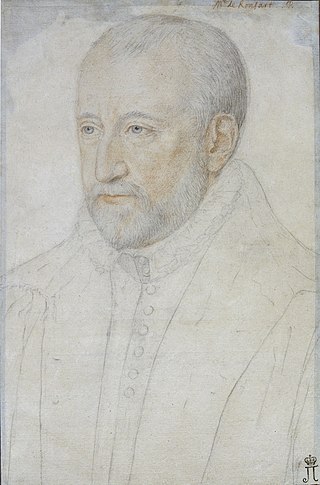
Pierre de Ronsard was a French poet or, as his own generation in France called him, a "prince of poets".

Gisborough Priory is a ruined Augustinian priory in Guisborough in the current borough of Redcar and Cleveland, North Yorkshire, England. It was founded in 1119 as the Priory of St Mary by the Norman feudal magnate Robert de Brus, also an ancestor of the Scottish king, Robert the Bruce. It became one of the richest monastic foundations in England with grants from the crown and bequests from de Brus, other nobles and gentry and local people of more modest means. Much of the Romanesque Norman priory was destroyed in a fire in 1289. It was rebuilt in the Gothic style on a grander scale over the following century. Its remains are regarded as among the finest surviving examples of early Gothic architecture in England.
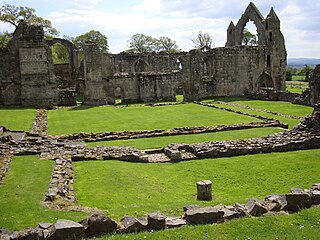
Haughmond Abbey is a ruined, medieval, Augustinian monastery a few miles from Shrewsbury, England. It was probably founded in the early 12th century and was closely associated with the FitzAlan family, who became Earls of Arundel, and some of their wealthier vassals and allies. It was a substantial, successful and wealthy house for most of its four centuries, although evidence of abuses appeared before its dissolution in 1539. The buildings fell into disrepair and the church was largely destroyed, although the remains of some of the domestic buildings remain impressive. The site is now in the care of English Heritage and is open to the public during the summer.

Woodspring Priory is a former Augustinian priory. It is near the scenic limestone promontory of Sand Point and Middle Hope, owned by the National Trust, beside the Severn Estuary about 3 miles (5 km) north-east of Weston-super-Mare, within the English unitary authority of North Somerset. Many of the buildings are Grade I listed, and the whole site is scheduled as an ancient monument.

Loches is a commune in the Indre-et-Loire department, central France.

The Priory of St. Mary the Virgin and St. Martin of the New Work, or Newark, commonly called Dover Priory, was a priory at Dover in southeast England. It was variously independent in rule, then occupied by canons regular of the Augustinian rule, then finally monks of the Benedictine rule as a cell of Christchurch Monastery, Canterbury.

Mattersey Priory is a former monastery of the Gilbertine order, located near the village of Mattersey, Nottinghamshire, England. It is currently managed by English Heritage.

Saint-Jeoire-Prieuré is a commune in the Savoie department in the Auvergne-Rhône-Alpes region of south-eastern France. It is part of the Canton of La Ravoire in the Arrondissement of Chambéry and included in the Grand Chambéry agglomeration community.

Richelieu is a commune in the Indre-et-Loire department in central France.

Hatfield Broad Oak Priory, or Hatfield Regis Priory, is a former Benedictine priory in Hatfield Broad Oak, Essex, England. Founded by 1139, it was dissolved in 1536 as part of Henry VIII's dissolution of the monasteries.
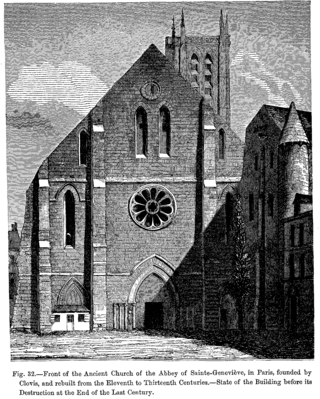
The Abbey of Saint Genevieve was a monastery in Paris. Reportedly built by Clovis, King of the Franks in 502, it became a centre of religious scholarship in the Middle Ages. It was suppressed at the time of the French Revolution.

Bourgueil Abbey was a Benedictine monastery located at Bourgueil, historically in Anjou, currently in Indre-et-Loire and the diocese of Angers. The founder was Emma of Blois, daughter of Theobald I of Blois, and by her marriage, duchess of Aquitaine.
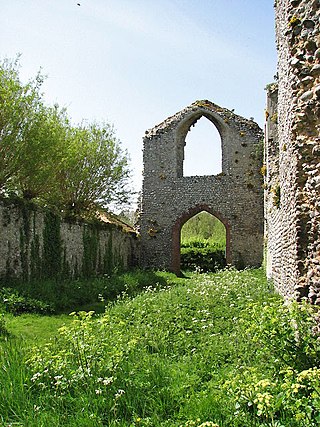
The Priory of St Mary in the Meadow, also known as Beeston Priory is a former Augustinian Priory, located in the village of Beeston Regis, Norfolk, United Kingdom.
Repton Priory was a priory in Repton, Derbyshire, England. It was established in the 12th century and was originally under the control of Calke Priory. It was dissolved in 1538.

Tonbridge Priory was a priory in Tonbridge, Kent, England that was established in 1124. It was destroyed by fire in 1337 and then rebuilt. The priory was disestablished in 1523. The building stood in 1735, but was a ruin by 1780. The remains of the priory were demolished in 1842 when the South Eastern Railway built the railway through Tonbridge, the original Tonbridge station standing on its site.

The Priory of Saint-Martin-des-Champs was an influential monastery established in what is now the city of Paris, France. Its surviving buildings are considered treasures of Medieval architecture in the city.
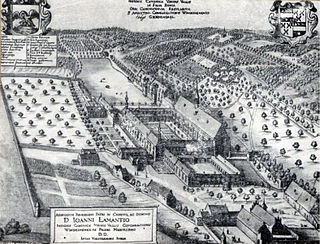
Groenendael Priory is located in the Forest of Soignes in the municipality of Hoeilaart in the Flemish Brabant, about 10 kilometres (6.2 mi) southeast of Brussels, Belgium.

Saint-Gabriel-Brécy Priory was a Benedictine priory 10 km from the coast between Caen and Bayeux. It is sited in the town of Saint-Gabriel-Brécy, Calvados, France. A 13th century gate-tower survives, with ogive vaulting on sculpted capitals. It was adjoined by a now-lost guesthouse. The cornice is sculpted with small three-point arches. The vaulted refectory dates to the late 13th century. A keep was built to serve as a prison in the 15th century, whilst the Renaissance-style courtroom was built towards the end of the 16th century. A dovecote is now lost.

The Priory of Le Plessis-Grimoult is a former Augustinian monastery established in the 12th century in Le Plessis-Grimoult in the department of Calvados, Normandy, France. The ruins were listed as a monument historique in 1928, and the nearby archaeological site and the remains of the fortified garden in 1996.

























